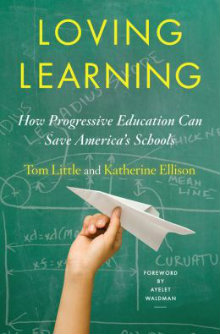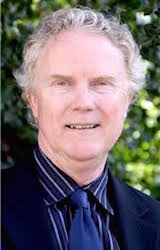Progressive Education: Can It Save America?
Loving Learning: How Progressive Education Can Save America’s Schools
By Tom Little and Katherine Ellison
(W.W. Norton & Co., 2015 – Learn more)

I found this book when browsing covers. I know we’re taught to not judge books by their covers but let’s be honest – we do. It wasn’t the graphics of the cover that really caught me, though; it was the title: Loving Learning. I love learning! I want my students to love learning! I was captivated.
And then a full stop at the subtitle: How Progressive Education Can Save America’s Schools. Insert eye roll.

As it turns out, the primary author of the book, Tom Little, served as a teacher and headmaster of the small, fiercely independent and proudly progressive Park Day School in Oakland, CA for over thirty years. This book serves as a last testament of sorts. Little wrote it in what he knew to be his final year as he was succumbing to bone cancer (he died in 2014).
One thing I’ve learned is that when a person lives and dies for something, it is almost always worth listening to them. Loving Learning is no exception.
Progressive schools past and present
This gem of a book is a grand tour of Park Day School, but a tour that simultaneously incorporates everything that Park Day represents as one of a few hundred progressive schools still standing in America. To this end, the authors assay dozens of other progressive schools from around the country, draw from an illustrious history, and point forward to a vision for a future of American schools that are invested in providing holistic opportunity for all children to learn.
Little is unabashed in his promotion of progressive schools, but he makes his case brilliantly with an ingenious collection of research (dating back to the progressive champion John Dewey and including the work of Vygotsky, Montessori, and a host of modern researchers), a cacophony of heart-warming and eye-popping anecdotes, and references to famous people who attended progressive schools and/or send their children to progressive schools (including Barack Obama, education secretary Arne Duncan, Chicago Mayor Rahm Emanuel, Dustin Hoffman, Matt Damon, Meg Ryan, Google founders Larry Page and Sergey Brin, Albert Einstein, and Gabriel Garcia Marquez to name a few!)
The result of Little and Ellison’s approach is that Loving Learning is both a very enjoyable read and a very convincing picture of a more idealistic school that can be – and indeed is being – implemented.
21st century best practices

Tom Little
Throughout the book, Little demonstrated a keen awareness of trends in best practices of education, connecting progressive pedagogy to such critical 21st century evidence-based practices and theories as social-emotional learning, universal design for learning (though never by name, certainly in practice), inquiry-based learning, and student-centric instruction. The progressive school’s stance on (against) standardized testing models – with explanation of alternative methods to promote assessment and feedback – is sure to make more than a few readers cheer (I know I did!)
Additionally, as a teacher who has worked in high-quality international schools, I was amazed to find so many of the practices I associated with certain models (e.g. the International Baccalaureate) or cutting edge practices I had studied (e.g. making thinking visible, universal design for learning) traced to progressive roots. It certainly seems as though many of the practices and philosophies I have come to hold dear are – in fact – practices that are embraced en masse in progressive pedagogy.
Unanswered questions
While this book is an outstanding accomplishment in terms of providing an unprecedented history and picture of progressive schools and their role in American education, it is not without some shortcomings. For one thing, the authors, in their zeal for the progressive movement and its history, occasionally come across as a little pompous. This is especially true when modern research corroborates practices that progressive schools have been using more intuitively for some time.
For example, Little writes at one point, “Once again, however, modern researchers have gone to the trouble of extensively confirming the value… that progressive teachers have followed for so many decades” (p. 98). Later, Little cites a recent National Research Council report related to conceptual frameworks, and demonstrates that progressive schools had this base covered as he speaks of to things he was doing in his classroom at Park Day thirty years ago.
On the one hand, I feel that the progressive education movement does deserve credit for promoting practices based on theoretical and case-study evidence; effectively, this has meant that such schools have been practicing methods for decades that have emerged recently as recommended best practices for all schools .
On the other hand, I still feel that the author’s occasional superior tone is unwarranted. Theory and case studies are very important, but do not, by themselves, equate empirical-evidence based practice. Moreover, progressive school teachers are not the only teachers who apply common sense and quality practice even before it is “proven.”
More importantly the authors of Loving Learning do little to address the larger question of how progressive school models can – in fact – save America’s schools. For example, while Little addresses how some progressive schools offer grants to intentionally accommodate students from low-income families, he does not provide insight into how the issue of providing small class sizes, field trips, and resource-intensive education can be funded in any larger-scale, public school model.
Or, while Little and Ellison provide arguments against standardized testing and provide alternatives, there is not much here for a public school teacher or administrator to use when facing legal requirements imposed by their districts and states.

A 2011 Maker Faire at Park Day School
Moreover, Little is in perpetual praise of the teachers at Park Day and other progressive schools, who by all accounts do appear to be exceptional in both their natural talent and work ethic, but the authors do little to address the negative aspect of such exceptionality. There is consideration of how the progressive model could expand if it requires such elite teachers – a cadre that may represent only a small fraction of the teachers in America.
Finally, as an academic I would have preferred that the references throughout the book be more traceable (Ellison’s background as a journalist often appears in the format of citations, which are often “according to Vygotsky” in nature), but I understand that the authors’ target audience is more broadly parents and teachers for whom a decidedly academic bent would be distracting. However, I did find the top ten books/studies related to the benefits of progressive education in an appendix to be helpful as a good place to start further study.
Right for one! Right for all?
Loving Learning took me by surprise. I was honestly amazed at how much ground Little and Ellison covered in this short work, which simultaneously provided me a rich understanding of progressivism and its role in American education and made me want to both work in and send my children to a progressive school.
I don’t yet see how progressive schools can change the landscape in American education as a whole, but as a believer in grassroots, I’m happy to know that they are there. I – for one – would be glad now to call myself a progressive educator. I do love learning, after all.
Eric Moore has served as a teacher on three continents in his eight years as an educator. He is an education PhD candidate at the University of Tennessee, where he is also serving as a graduate assistant. Eric has earned numerous scholarships and a fellowship for his championing of social justice in education and his commitment to diversity. His most recent publication regarding postsecondary programs for individuals with intellectual disabilities was published in the Journal of Intellectual Disabilities.


































